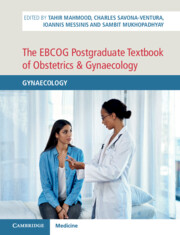Book contents
- The EBCOG Postgraduate Textbook of Obstetrics & Gynaecology
- The EBCOG Postgraduate Textbook of Obstetrics & Gynaecology
- Copyright page
- Dedication
- Contents
- Videos
- Contributors
- Preface
- Section 1 Basic Sciences in Gynaecology
- Section 2 Menstrual Disorders
- Section 3 Reproductive Endocrinology and Infertility
- Section 4 Contraception and STIs
- Chapter 20 Hormonal and Non-hormonal Contraceptives
- Chapter 21 Female and Male Sterilization
- Chapter 22 Management of Unintended Pregnancy
- Chapter 23 Recurrent Vulvovaginitis
- Chapter 24 Sexually Transmitted Infection and Pelvic Inflammatory Disease
- Section 5 Post-Reproductive Care
- Section 6 Vulva and Vagina
- Section 7 Cervix
- Section 8 Uterus
- Section 9 Ovary and Fallopian Tubes
- Section 10 Operative Gynaecology
- Section 11 Public Health Issues in Gynaecology
- Section 12 Miscellaneous
- Index
- Plate Section (PDF Only)
- References
Chapter 22 - Management of Unintended Pregnancy
from Section 4 - Contraception and STIs
Published online by Cambridge University Press: 24 November 2021
- The EBCOG Postgraduate Textbook of Obstetrics & Gynaecology
- The EBCOG Postgraduate Textbook of Obstetrics & Gynaecology
- Copyright page
- Dedication
- Contents
- Videos
- Contributors
- Preface
- Section 1 Basic Sciences in Gynaecology
- Section 2 Menstrual Disorders
- Section 3 Reproductive Endocrinology and Infertility
- Section 4 Contraception and STIs
- Chapter 20 Hormonal and Non-hormonal Contraceptives
- Chapter 21 Female and Male Sterilization
- Chapter 22 Management of Unintended Pregnancy
- Chapter 23 Recurrent Vulvovaginitis
- Chapter 24 Sexually Transmitted Infection and Pelvic Inflammatory Disease
- Section 5 Post-Reproductive Care
- Section 6 Vulva and Vagina
- Section 7 Cervix
- Section 8 Uterus
- Section 9 Ovary and Fallopian Tubes
- Section 10 Operative Gynaecology
- Section 11 Public Health Issues in Gynaecology
- Section 12 Miscellaneous
- Index
- Plate Section (PDF Only)
- References
Summary
Unintended pregnancy is common. It is estimated that one in three pregnancies end in abortion. Management of unintended pregnancy, in the form of surgical and medical abortion, is an essential part of reproductive healthcare and fundamental for training in obstetrics and gynaecology. Comprehensive abortion care includes provision of accurate information on methods of abortion, provision of abortion and post-abortion care.
This chapter will provide background on the prevalence of abortion, pre-abortion assessment, methods of abortion, post-abortion contraception and management of abortion-related complications.
Keywords
- Type
- Chapter
- Information
- The EBCOG Postgraduate Textbook of Obstetrics & GynaecologyGynaecology, pp. 175 - 181Publisher: Cambridge University PressPrint publication year: 2021

